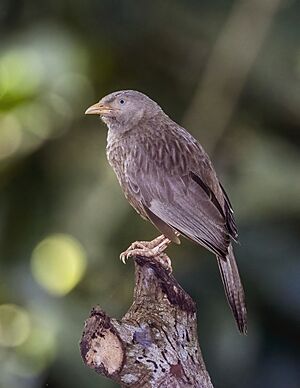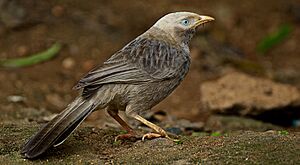Yellow-billed babbler facts for kids
Quick facts for kids Yellow-billed babbler |
|
|---|---|
 |
|
| A. a. taprobanus, Sri Lanka |
|
| Conservation status | |
| Scientific classification | |
| Synonyms | |
|
Turdoides affinis |
The yellow-billed babbler (Argya affinis) is a small, noisy bird found only in southern India and Sri Lanka. It's a common bird that lives in gardens, farms, and bushy areas. These babblers don't fly far because they have short, rounded wings. They usually move around in groups, making lots of sounds as they look for food. People sometimes confuse them with the jungle babbler, but the yellow-billed babbler has a different call and prefers greener places.
Contents
About the Yellow-Billed Babbler
The yellow-billed babbler belongs to a bird family called Leiothrichidae. Scientists used to place it in a group called Turdoides. But after a detailed study in 2018, it was moved to a different group, or genus, called Argya. This change helps scientists understand how different bird species are related.
What They Look Like
These birds have grey-brown feathers on their backs. Their throats and chests are grey with some spots, and their bellies are a pale, creamy color. Their heads and the back of their necks are grey, and their eyes are a pretty bluish-white.
In southern India, the birds have a whitish top of the head and neck. Their backs are a bit darker. The birds in Sri Lanka, called A. a. taprobanus, are a lighter, dull grey. Birds in the very south of India look similar to the Sri Lankan ones.
Yellow-billed babblers make seven different kinds of sounds. Their calls are higher-pitched than those of the jungle babbler. Jungle babblers have calls that sound rougher and more like a nose sound.
Where They Live
You can find these birds in certain areas of southern India and Sri Lanka. In India, they live south of the Godavari river in Andhra Pradesh and south of Belgaum in Karnataka, stretching into Tamil Nadu. They like places that are not too high up and are a bit dry. Sometimes, they live in the same areas as jungle babblers.
In Sri Lanka, they live in lowlands and hills up to about 1500 meters high. They avoid thick forests. They are often seen in gardens and frequently visit towns and cities.
Daily Life and Habits
Yellow-billed babblers usually live in groups of seven to ten birds, or even more. They are very noisy birds! You can often hear a flock from far away because of their constant chattering, squeaking, and chirping. Sometimes, they all start chattering so loudly it can be quite noticeable.
One bird often sits high up, acting as a lookout. This sentinel bird watches for danger while the rest of the group looks for food on the ground. They mostly eat insects, but they also enjoy fruits, flower nectar, and even human food scraps. They have been seen eating small lizards and whip-scorpions.
These birds don't fly long distances. The longest they've been seen flying without stopping is about 180 meters. Before they fly, they usually climb up a tree or a tall bush to get some height. Other birds like black drongos and rufous treepies, and even Indian palm squirrels, are often seen looking for food near these babblers.
The babblers wake up before sunrise, around 6:00 AM, and start looking for food. They are less active during the hottest parts of the day, from about 1:30 PM to 4:30 PM. In the evening, around 7:00 PM, they gather in groups and clean their feathers before going to sleep. Group members sleep close to each other, with younger birds sometimes snuggling in the middle.
When they are looking for food, the lookout bird makes calls and flutters its wings while hopping. They often preen each other, especially in winter. Sometimes, one bird might beg for food from another. Yellow-billed babblers love to bathe. They often visit birdbaths in their area, usually in the late afternoon or evening. They have even been seen bathing after sunset, around 6:30 PM.
A study in the Sivakasi plains found that groups of these birds had a home area of about 0.4 square kilometers. There were about 55 birds in every square kilometer.
Life Cycle and Reproduction
Yellow-billed babblers build nests all year round. However, they build the most nests just before the southwest monsoon season in India begins. They build their nests in trees, hidden among thick leaves. Most nests are built less than four meters off the ground.
The nest is a small cup shape, placed in the fork of a tree branch. The female usually lays two to four turquoise blue eggs. Birds in the hills of Sri Lanka might lay up to five eggs. The eggs hatch after 14 to 16 days. The parent bird sitting on the eggs often stands on the edge of the nest instead of sitting directly on the chicks.
Sometimes, other birds lay their eggs in the babblers' nests. This is called brood parasitism. The pied cuckoo and the common hawk-cuckoo are known to do this in both India and Sri Lanka. In one unusual case, jungle babblers were seen feeding the chicks of yellow-billed babblers. The babbler chicks are mainly fed insects and sometimes a small lizard.
Like most birds, the parents keep the nest clean by removing the chicks' waste. They usually swallow it. Other birds, called "helpers," sometimes assist the parents. They help build the nest and feed the chicks.
Dangers They Face
Animals that eat the eggs of yellow-billed babblers include mongooses, crows, and the greater coucal. These animals might also eat the chicks. Rat snakes can sometimes take chicks from the nest.
In Culture
In Sri Lanka, this bird is known as demalichcha in the Sinhala language. In Tamil Nadu, this bird is known by several names in the Tamil language. These include Thavittu-kuruvi, Pandri-kuruvi, Velaikkara-kuruvi, Kalani-kuruvi, and Pooniyal kuruvi.



